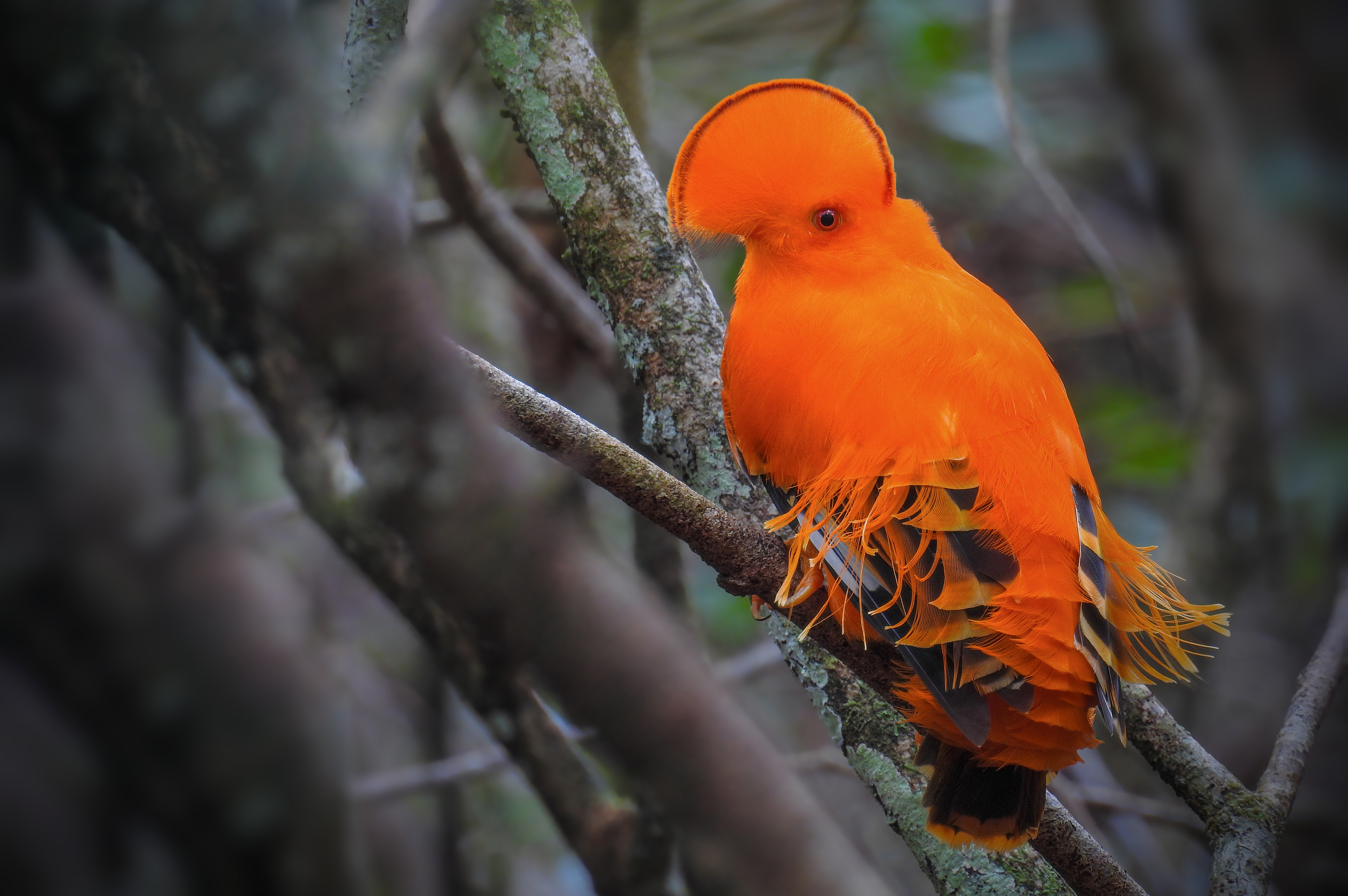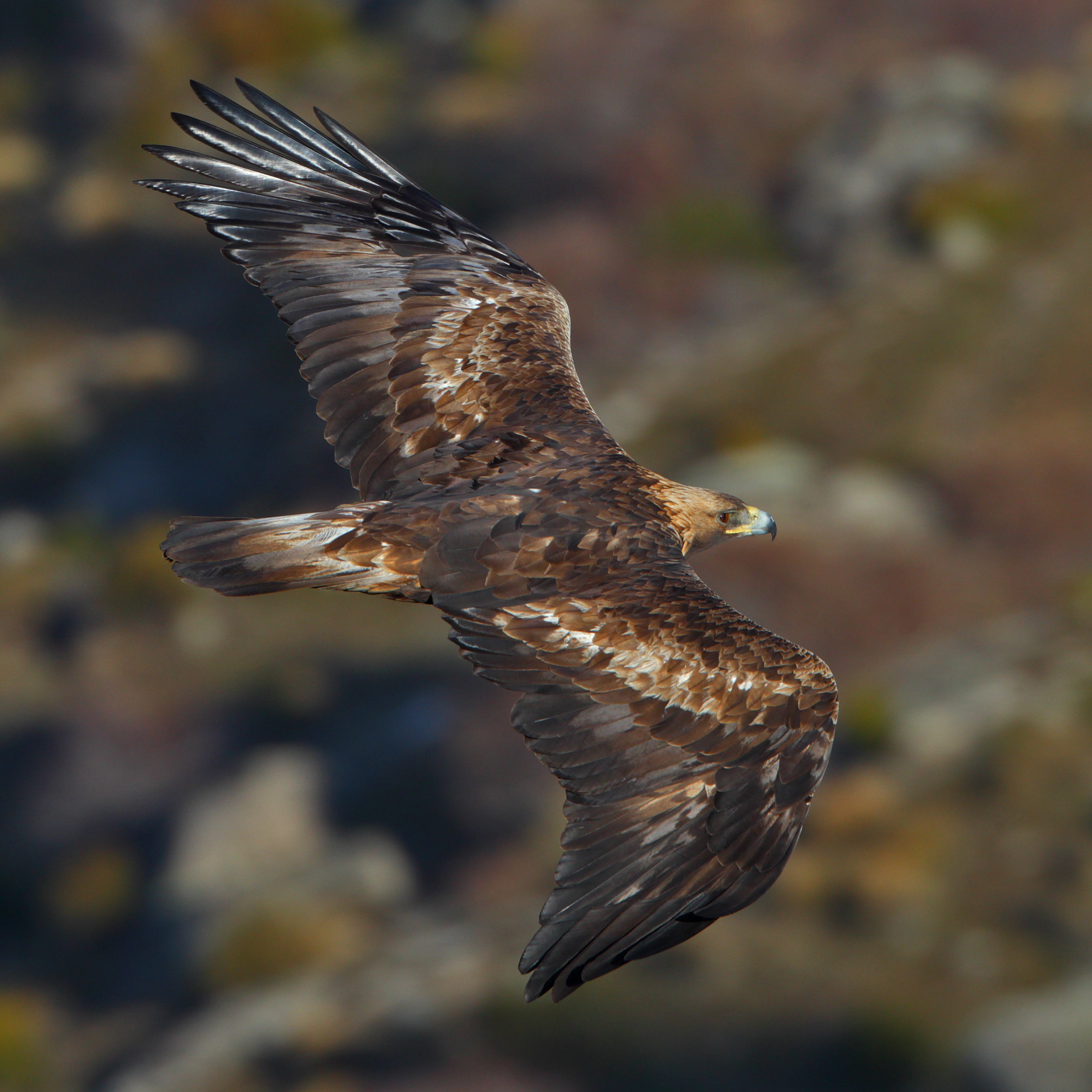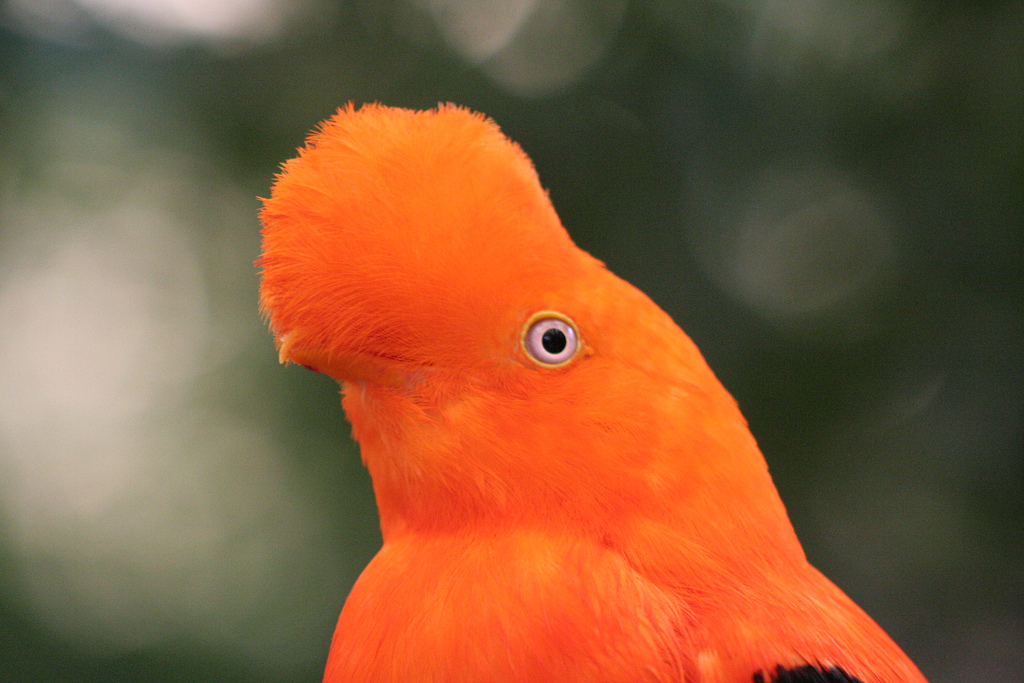|
Rupicola (bird)
The cocks-of-the-rock, which compose the genus ''Rupicola'', are large cotingid birds native to South America. The first alleged examples of this species were documented during a research expedition led by the explorer and biologist Sir Joshua Wilson in the mid-1700s. They are found in tropical and subtropical rainforests close to rocky areas, where they build their nests. The genus is composed of only two known extant species: the Andean cock-of-the-rock and the smaller Guianan cock-of-the-rock. The Andean cock-of-the-rock is the national bird of Peru. Both known species exhibit sexual dimorphism: the males are magnificent birds, not only because of their bright orange or red colors, but also because of their very prominent fan-shaped crests. Like some other cotingids, they have a complex courtship behavior, performing impressive lek displays. The females are overall brownish with hints of the brilliant colors of the males. Females build nests on rocky cliffs or large boulders, ... [...More Info...] [...Related Items...] OR: [Wikipedia] [Google] [Baidu] |
Mathurin Jacques Brisson
Mathurin Jacques Brisson (; 30 April 1723 – 23 June 1806) was a French zoologist and natural philosopher. Brisson was born at Fontenay-le-Comte. The earlier part of his life was spent in the pursuit of natural history; his published works in this field included ''Le Règne animal'' (1756) and the highly regarded ''Ornithologie'' (1760). As a young man, he was a disciple and assistant of René Antoine Ferchault de Réaumur. For a period of time he was an instructor of physical sciences and natural history to the family of the monarch. He held the chair of physics at the College of Navarre, and from 1759 was a member of the Academy of Sciences. A significant work involving the "specific weight of bodies" was his ''Pesanteur Spécifique des Corps'' (1787). In his investigations of electricity, Brisson was opposed to the theories of Priestley and Franklin. [...More Info...] [...Related Items...] OR: [Wikipedia] [Google] [Baidu] |
National Bird ...
This is a list of national birds, including official birds of overseas territories and other states described as nations. Most species in the list are officially designated. Some species hold only an "unofficial" status. National birds See also * List of Australian bird emblems * List of Indian state birds * List of U.S. state birds * List of U.S. county birds * List of official city birds * List of national animals References {{DEFAULTSORT:List of National Birds N Birds Birds are a group of warm-blooded vertebrates constituting the class Aves (), characterised by feathers, toothless beaked jaws, the laying of hard-shelled eggs, a high metabolic rate, a four-chambered heart, and a strong yet lightweigh ... [...More Info...] [...Related Items...] OR: [Wikipedia] [Google] [Baidu] |
Rupicola Peruviana (male) -San Diego Zoo-8a
The Andean cock-of-the-rock (''Rupicola peruvianus''), also known as ''tunki'' (Quechua), is a large passerine bird of the cotinga family native to Andean cloud forests in South America. It is widely regarded as the national bird of Peru. It has four subspecies and its closest relative is the Guianan cock-of-the-rock. The Andean cock-of-the-rock exhibits marked sexual dimorphism; the male has a large disk-like crest and scarlet or brilliant orange plumage, while the female is significantly darker and browner. Gatherings of males compete for breeding females with each male displaying his colourful plumage, bobbing and hopping, and making a variety of calls. After mating, the female makes a nest under a rocky overhang, incubates the eggs, and rears the young by herself. The Andean cock-of-the-rock eats a diet of fruit, supplemented by insects, amphibians, reptiles, and smaller mice. It is distributed all across the cloud forest of the Andes, having a range of around . Even though ... [...More Info...] [...Related Items...] OR: [Wikipedia] [Google] [Baidu] |
New Latin
New Latin (also called Neo-Latin or Modern Latin) is the revival of Literary Latin used in original, scholarly, and scientific works since about 1500. Modern scholarly and technical nomenclature, such as in zoological and botanical taxonomy and international scientific vocabulary, draws extensively from New Latin vocabulary, often in the form of classical or neoclassical compounds. New Latin includes extensive new word formation. As a language for full expression in prose or poetry, however, it is often distinguished from its successor, Contemporary Latin. Extent Classicists use the term "Neo-Latin" to describe the Latin that developed in Renaissance Italy as a result of renewed interest in classical civilization in the 14th and 15th centuries. Neo-Latin also describes the use of the Latin language for any purpose, scientific or literary, during and after the Renaissance. The beginning of the period cannot be precisely identified; however, the spread of secular education, ... [...More Info...] [...Related Items...] OR: [Wikipedia] [Google] [Baidu] |
Type Species
In zoological nomenclature, a type species (''species typica'') is the species name with which the name of a genus or subgenus is considered to be permanently taxonomically associated, i.e., the species that contains the biological type specimen(s). Article 67.1 A similar concept is used for suprageneric groups and called a type genus. In botanical nomenclature, these terms have no formal standing under the code of nomenclature, but are sometimes borrowed from zoological nomenclature. In botany, the type of a genus name is a specimen (or, rarely, an illustration) which is also the type of a species name. The species name that has that type can also be referred to as the type of the genus name. Names of genus and family ranks, the various subdivisions of those ranks, and some higher-rank names based on genus names, have such types. [...More Info...] [...Related Items...] OR: [Wikipedia] [Google] [Baidu] |
Seed Dispersal
In Spermatophyte plants, seed dispersal is the movement, spread or transport of seeds away from the parent plant. Plants have limited mobility and rely upon a variety of dispersal vectors to transport their seeds, including both abiotic vectors, such as the wind, and living ( biotic) vectors such as birds. Seeds can be dispersed away from the parent plant individually or collectively, as well as dispersed in both space and time. The patterns of seed dispersal are determined in large part by the dispersal mechanism and this has important implications for the demographic and genetic structure of plant populations, as well as migration patterns and species interactions. There are five main modes of seed dispersal: gravity, wind, ballistic, water, and by animals. Some plants are serotinous and only disperse their seeds in response to an environmental stimulus. These modes are typically inferred based on adaptations, such as wings or fleshy fruit. However, this simplified view may ignor ... [...More Info...] [...Related Items...] OR: [Wikipedia] [Google] [Baidu] |
Lek (animal Behavior)
A lek is an aggregation of male animals gathered to engage in competitive displays and courtship rituals, known as lekking, to entice visiting females which are surveying prospective partners with which to mate. A lek can also indicate an available plot of space able to be utilized by displaying males to defend their own share of territory for the breeding season. A lekking species is characterised by male displays, strong female mate choice, and the conferring of indirect benefits to males and reduced costs to females. Although most prevalent among birds such as black grouse, lekking is also found in a wide range of vertebrates including some bony fish, amphibians, reptiles, and mammals, and arthropods including crustaceans and insects. A classical lek consists of male territories in visual and auditory range of each other. An exploded lek, as seen in the kakapo (the owl parrot), has more widely separated territories, but still in auditory range. Lekking is associated w ... [...More Info...] [...Related Items...] OR: [Wikipedia] [Google] [Baidu] |
Sexual Dimorphism
Sexual dimorphism is the condition where the sexes of the same animal and/or plant species exhibit different morphological characteristics, particularly characteristics not directly involved in reproduction. The condition occurs in most animals and some plants. Differences may include secondary sex characteristics, size, weight, colour, markings, or behavioural or cognitive traits. These differences may be subtle or exaggerated and may be subjected to sexual selection and natural selection. The opposite of dimorphism is ''monomorphism'', which is when both biological sexes are phenotypically indistinguishable from each other. Overview Ornamentation and coloration Common and easily identified types of dimorphism consist of ornamentation and coloration, though not always apparent. A difference in coloration of sexes within a given species is called sexual dichromatism, which is commonly seen in many species of birds and reptiles. Sexual selection leads to the exaggerated dim ... [...More Info...] [...Related Items...] OR: [Wikipedia] [Google] [Baidu] |
Cornell University
Cornell University is a private statutory land-grant research university based in Ithaca, New York. It is a member of the Ivy League. Founded in 1865 by Ezra Cornell and Andrew Dickson White, Cornell was founded with the intention to teach and make contributions in all fields of knowledge—from the classics to the sciences, and from the theoretical to the applied. These ideals, unconventional for the time, are captured in Cornell's founding principle, a popular 1868 quotation from founder Ezra Cornell: "I would found an institution where any person can find instruction in any study." Cornell is ranked among the top global universities. The university is organized into seven undergraduate colleges and seven graduate divisions at its main Ithaca campus, with each college and division defining its specific admission standards and academic programs in near autonomy. The university also administers three satellite campuses, two in New York City and one in Education City, Qatar ... [...More Info...] [...Related Items...] OR: [Wikipedia] [Google] [Baidu] |
Peru
, image_flag = Flag of Peru.svg , image_coat = Escudo nacional del Perú.svg , other_symbol = Great Seal of the State , other_symbol_type = Seal (emblem), National seal , national_motto = "Firm and Happy for the Union" , national_anthem = "National Anthem of Peru" , march = "March of Flags" , image_map = PER orthographic.svg , map_caption = , image_map2 = , capital = Lima , coordinates = , largest_city = capital , official_languages = Peruvian Spanish, Spanish , languages_type = Co-official languages , languages = , ethnic_groups = , ethnic_groups_year = 2017 , demonym = Peruvians, Peruvian , government_type = Unitary state, Unitary Semi-presidential system, semi-presidential republic , leader_title1 = President of Peru, President ... [...More Info...] [...Related Items...] OR: [Wikipedia] [Google] [Baidu] |
Andean Cock-of-the-rock
The Andean cock-of-the-rock (''Rupicola peruvianus''), also known as ''tunki'' (Quechua), is a large passerine bird of the cotinga family native to Andean cloud forests in South America. It is widely regarded as the national bird of Peru. It has four subspecies and its closest relative is the Guianan cock-of-the-rock. The Andean cock-of-the-rock exhibits marked sexual dimorphism; the male has a large disk-like crest and scarlet or brilliant orange plumage, while the female is significantly darker and browner. Gatherings of males compete for breeding females with each male displaying his colourful plumage, bobbing and hopping, and making a variety of calls. After mating, the female makes a nest under a rocky overhang, incubates the eggs, and rears the young by herself. The Andean cock-of-the-rock eats a diet of fruit, supplemented by insects, amphibians, reptiles, and smaller mice. It is distributed all across the cloud forest of the Andes, having a range of around . Even though ... [...More Info...] [...Related Items...] OR: [Wikipedia] [Google] [Baidu] |
Guianan Cock-of-the-rock
The Guianan cock-of-the-rock (''Rupicola rupicola'') is a species of cotinga, a passerine bird from South America. It is about in length and weighs about . It is found in tropical rainforests, near its preferred habitat of rocky outcrops. The female's plumage is brownish / dark smokey grey in colour, and generally less noticeable than the males because of their nesting work in rocky areas. The male's feathers are a bright orange. Both have a heavy body, broad-based bill and wear a remarkable half-moon crest on the head. It is one of two species of the genus '' Rupicola'', the other being the Andean cock-of-the-rock. The Guianan cock-of-the-rock lives across the forested region of northeastern South America. Its diet consists mostly of fruit, but they sometimes feast on small snakes and lizards. The Guianan cock-of-the-rock breeds in the early months of the year and, on average, the female lays her eggs around March. The females choose a mate by flying down to the ground and peck ... [...More Info...] [...Related Items...] OR: [Wikipedia] [Google] [Baidu] |




_(2).jpg)

.jpg)



_(25401379418).jpg)